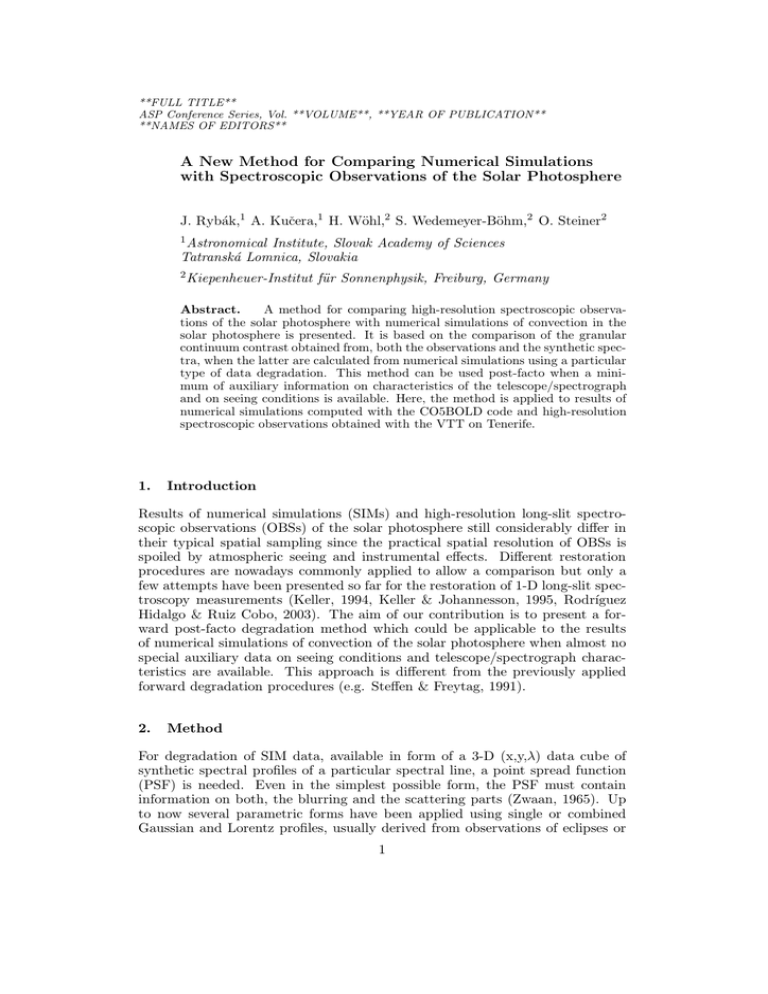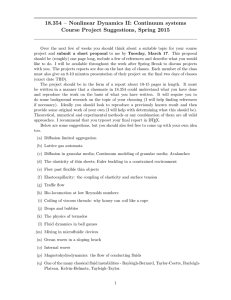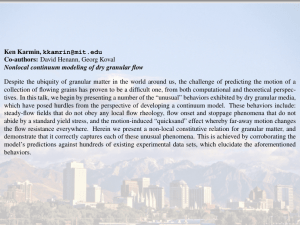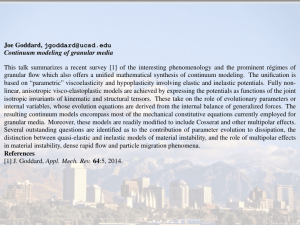A New Method for Comparing Numerical Simulations
advertisement

**FULL TITLE** ASP Conference Series, Vol. **VOLUME**, **YEAR OF PUBLICATION** **NAMES OF EDITORS** A New Method for Comparing Numerical Simulations with Spectroscopic Observations of the Solar Photosphere J. Rybák,1 A. Kučera,1 H. Wöhl,2 S. Wedemeyer-Böhm,2 O. Steiner2 1 Astronomical Institute, Slovak Academy of Sciences Tatranská Lomnica, Slovakia 2 Kiepenheuer-Institut für Sonnenphysik, Freiburg, Germany Abstract. A method for comparing high-resolution spectroscopic observations of the solar photosphere with numerical simulations of convection in the solar photosphere is presented. It is based on the comparison of the granular continuum contrast obtained from, both the observations and the synthetic spectra, when the latter are calculated from numerical simulations using a particular type of data degradation. This method can be used post-facto when a minimum of auxiliary information on characteristics of the telescope/spectrograph and on seeing conditions is available. Here, the method is applied to results of numerical simulations computed with the CO5BOLD code and high-resolution spectroscopic observations obtained with the VTT on Tenerife. 1. Introduction Results of numerical simulations (SIMs) and high-resolution long-slit spectroscopic observations (OBSs) of the solar photosphere still considerably differ in their typical spatial sampling since the practical spatial resolution of OBSs is spoiled by atmospheric seeing and instrumental effects. Different restoration procedures are nowadays commonly applied to allow a comparison but only a few attempts have been presented so far for the restoration of 1-D long-slit spectroscopy measurements (Keller, 1994, Keller & Johannesson, 1995, Rodrı́guez Hidalgo & Ruiz Cobo, 2003). The aim of our contribution is to present a forward post-facto degradation method which could be applicable to the results of numerical simulations of convection of the solar photosphere when almost no special auxiliary data on seeing conditions and telescope/spectrograph characteristics are available. This approach is different from the previously applied forward degradation procedures (e.g. Steffen & Freytag, 1991). 2. Method For degradation of SIM data, available in form of a 3-D (x,y,λ) data cube of synthetic spectral profiles of a particular spectral line, a point spread function (PSF) is needed. Even in the simplest possible form, the PSF must contain information on both, the blurring and the scattering parts (Zwaan, 1965). Up to now several parametric forms have been applied using single or combined Gaussian and Lorentz profiles, usually derived from observations of eclipses or 1 2 Rybák, Kučera, Wöhl, Wedemeyer-Böhm, Steiner planet transits. Keeping our method as simple as possible the blurring part of the PSF is deduced from its Fourier transform – the optical transfer function (OTF) – using theoretical relations derived for the case of long exposures (>1s). In this case the OTF can be factorized by a two component formula separating the atmospheric and telescopic contributions using just 3 control parameters – the Fried parameter r0 , the telescope aperture D, and the wavelength λ (von der Lühe, 1992; Bonet, 1999). The scattering part of the PSF is in fact a rather long-tail monotonic function seen in detailed limb/aureole measurements (e.g. Deubner & Mattig, 1975). Having in mind that the typical photospheric granular size is considerably smaller than the spatial extent of available SIMs, we prefer to mimic the effect of scattering via a constant background, independent on the scattering angle over the whole spatial domain of the SIMs. Hereafter, the PSF will therefore be approximated as P SF = P SFblur + P SFscatt = P SFlong−exp (D, r0 ) + C (1) where the term P SFlong−exp is given by the equations given in the work of Bonet (1999). Two free parameters, r0 (alternatively, the radius of the seeing disk λ/r0 ) and C, have to be determined to fully describe such an approximation to the PSF. The granular contrast of the continuum intensity, δIrms , is used as a criterion to determine the appropriate values of λ/r0 and C. In case of OBSs, the value of the mean granular contrast, δIrms,obs , is derived from many exposures of 1-D slit spectra of the quiet photosphere. For the SIMs, the mean value of the granular contrast, δIrms,sim , from several snapshots is calculated for several test PSFs with different combinations of the parameters λ/r0 and C. Moreover, effects of sampling the 2-D spatial domain of the snapshots by a ’virtual slit’ of a width equal to that used in the OBSs, detector pixel length along the slit, and estimation of the instrumental profile are introduced. Comparing δIrms,obs , derived from OBSs, with the range of δIrms,sim , determined for test degradation results of SIMs, the appropriate values of the parameters λ/r0 and C can be deduced. Values of δIrms,obs and δIrms,sim should coincide for such parameters. Finally, these values are used for the PSF to be applied to the SIMs in each spectral plane together with additional degradation for the slit/detector sampling. 3. Data The described method has been tested using observational data described by Rybák et al. (2004) and synthetic spectra based on the results of numerical simulations by Wedemeyer et al. (2004). Briefly, spectroscopic observations were performed using the Vacuum Tower Telescope (VTT) on Tenerife. The Fe II 6458 Å line was taken with an exposure time of 1 s, while the slit width was 0.5′′ and the detector pixel size along the slit 0.125′′ . 300 spectra were acquired at center-to-limb position µ=0.65 with 600 spectral rows along the slit giving an average value of the granular contrast δIrms,obs equal to 0.021. The non-magnetic 3-D numerical simulations cover a spatial domain of 7.7′′ × 7.7′′ with a horizontal cell spacing of 0.055′′ . In total, 52 snapshots with the temporal step of 3 min were calculated. The LTE radiative transfer code LINFOR3D was Method for comparing simulations with observations 3 GRANULAR CONTRAST rms(I_c) 0.10 0.09 0.08 0.08 0.07 S/B PSF RATIO 0.06 0.06 0.05 0.04 0.04 0.03 0.02 0.02 0.01 0.00 0.00 0.2 0.4 0.6 0.8 PSF HALF-WIDTH [arcsec] 1.0 Figure 1. 2-D map of the simulated granular contras, δIrms,sim , as a function of the half-width of the blurring part of the PSF and the ratio between the blurring and scattering parts of the PSF, using all 52 snapshots of the SIMs. The white mainly vertical curve marks the granular contrast, derived from the OBSs, δIrms,obs . The grey horizontal line corresponds to the estimated level of scattered light converted to the ratio between the scattering and blurring part of the PSF. used for calculating synthetic spectra of the Fe II 6456 Å line for the same centerto-limb position. From the simulations resulted an average value of the granular contrast, δIrms,sim , equal to 0.146±0.006. 4. Application Diverse degradations were applied to the SIMs corresponding to values of the PSF half-width of 0.14′′ to 1.05′′ and C of 0.0 to 5.5×10−5 (i.e. the relative ratio between the scattering and the blurring parts of the PSF of 0.0 to 0.096). For comparison, the theoretical resolution of the VTT is 0.23′′ at our wavelength and a scattered light level of a few percent was reported for the VTT telescope. The resulting 2-D map of the granular contrast derived from all snapshots is shown in Fig.1. It shows that for a given granular contrast the PSF half-width and the scattered light level are not uniquely determined as they slightly depend on the applied scattered light level. The granular contrast of our observations, δIrms,obs , is reached within the interval of the PSF half-width from 0.60′′ to 0.65′′ (Fig.1, white curve). An estimation of the scattered light level is inevitable to solve the ambiguity. Data taken during the Mercury transit in 2003 (Soltau, 2005) were found to be the most appropriate for this purpose. Assuming that exclusively scattering is causing the rest intensity at the Mercury disk center (6 % of the nearby continuum at 5725±5 Å), a background scattered light level of just 2.2×10−6 is derived for each pixel of the spatial domain of the SIMs. The corresponding ratio between the scattering and blurring parts of the PSF 4 Rybák, Kučera, Wöhl, Wedemeyer-Böhm, Steiner 1.4 1.1 1.3 1.0 1.2 2 1.1 1.0 0.9 0 0.8 0.7 0.6 -2 SPATIAL SCALE X [arc sec] SPATIAL SCALE X [arc sec] 2 0.9 0.8 0 0.7 0.6 -2 0.5 0.5 0.4 0.3 -0.2 -0.1 -0.0 0.1 WAVELENGTH [A] 0.2 0.4 -0.2 -0.1 -0.0 0.1 WAVELENGTH [A] 0.2 Figure 2. Example spectra of a spatial cut from a simulation snapshot (intensities are normalized to the spatially averaged value of the continuum intensity). The left panel shows the original synthetic spectrum of the Fe II 6456 Å spectral line. The right panel gives for comparison the same spectrum degraded for all degradation effects taken into account. is then 0.038 (Fig.1, grey line). The intersection of the white with the grey curve (Fig.1) gives the optimal value of the PSF full-width equal to 1.25′′ . This value corresponds to a Fried parameter r0 of 11 cm what is in agreement with the typical values of r0 derived for the best observing sites like Canary Islands (Brandt & Wöhl) and Sacramento Peak (Brandt, Mauter & Smartt, 1987). 5. Results Fig.2 shows an example of an original and a degraded SIM spectrum. Besides a decrease of the intensity range from [0.3,1.4] to [0.4,1.1], a remarkable degradation of the spectral profiles is found. For example, the range of the line-ofsight velocities, derived from the Doppler shifts, changes from ±5 km/s to only ±1 km/s. Almost all (99.6%) of our observed Doppler shifts are within the latter velocity interval. The effects of the degradation procedure on distributions of two spectral line characteristics – the continuum intensity and the full-width at half minimum of the line (FWHM) – are shown in Fig.3, where histograms of these quantities are displayed. They have been calculated for the position µ=0.65 taking each snapshot individually. The histograms of the continuum intensity of the original SIM data show a wide range of values with an almost flat central part in the interval 0.8 to 1.2. The degradation procedure significantly narrows these distributions to the interval [0.9,1.1] but the significant part of the data are within the interval [0.94,1.06]. Generally, individual distributions keep their significant statistical differences also after degradation. The distribution of the line width of the original SIM data is very asymmetric. Therefore, the most frequent value of this quantity is shifted by 10 % 5 Method for comparing simulations with observations CONTINUUM INTENSITY DISTRIBUTION FWHM DISTRIBUTION 1.000 1.000 0.100 0.100 Synthetic spectra 0.010 Synthetic spectra 0.010 0.001 0.001 1.000 1.000 Synthetic spectra + PSF + slit + IP Synthetic spectra + PSF + slit + IP 0.100 0.100 0.010 0.010 0.001 0.001 0.6 0.8 1.0 1.2 NORMALIZED CONTINUUM INTENSITY Ic 1.4 0.5 1.0 1.5 2.0 NORMALIZED FWHM 2.5 3.0 Figure 3. Distributions of the continuum intensity (left column) and the line width (right column) for all individual snapshots from the original simulation data (top row) and for the same data degraded for all effects including the PSF, the slit width, detector pixel sampling, and the estimated instrumental profile of the VTT echelle spectrograph (bottom row). from the mean value. Again, the degradation is removing the far wings of the distributions below 0.8 and above 1.4. The distributions are still asymmetric and significant variations between individual distributions are present. A comparison of the average distributions of the normalized FWHM coming from OBSs and from degraded SIMs for µ=0.65 is given in Fig.4. Both distributions show similar asymmetry but the distribution from the SIMs is broader. The difference is more pronounced for the tail of large values (∼20 %). For checking purposes, we have calculated a similar distribution for the continuum intensity (Fig.4). It advices that the PSF might be still a bit underestimated as the distribution of the SIMs is still broader than that of the OBSs. These preliminary results demonstrate the possible usage of this method for statistical comparison of high-resolution spectroscopic observations with synthetic data obtained from numerical simulations. 6 Rybák, Kučera, Wöhl, Wedemeyer-Böhm, Steiner CONTINUUM INTENSITY DISTRIBUTION FWHM DISTRIBUTION 1.0000 1.0000 0.1000 0.1000 SIMs 0.0100 0.0100 OBSs 0.0010 0.0001 0.8 SIMs OBSs 0.0010 0.0001 0.9 1.0 NORMALIZED Ic 1.1 1.2 0.8 1.0 1.2 NORMALIZED FWHM 1.4 1.6 Figure 4. Average distributions of the continuum intensity (left panel) and the full-width at half minimum (right panel) for the degraded simulation data (thin line) and for the observational data (thick line) for a a heliocentric angle of µ=0.65. Distributions are normalized to the mean value of the particular spectral characteristic. Acknowledgments. The VTT is operated by the Kiepenheuer-Institut für Sonnenphysik, Freiburg, at the Observatorio del Teide. This research is part of the European Solar Magnetism Network (EC/RTN contract HPRN-CT-200200313). This work was supported by the Slovak grant agency VEGA(2/6195/26) and by the Deutsche Forschungsgemeinschaft (DFG 436 SLK 113/7). The authors thank D. Soltau for the Mercury transit data used in this work and the NSO/SP workshop organizers for kindly providing valuable support. References Bonet, J. A. 1999, in Motions in the Solar Atmosphere, ed. A. Hanslmeier & M. Messerotti (Dordrecht: Kluwer), Astrophysics and Space Science Library, 239, 1 Brandt, P.N. & Wöhl, H. 1982, A&A, 109, 77 Brandt, P.N., Mauter, H.A., & Smartt, R. 1987, A&A, 188, 163 Deubner, F.L. & Mattig, W. 1975, A&A, 45, 167 Keller, C.U. 1994, in Solar Surface Magnetism, ed. R. J. Rutten, & C. J. Schrijver (Dordrecht: Kluwer), 43 Keller, C.U. & Johannesson, A., 1995, A&ASS, 110, 565 Luehe, O. von der 1992, in Solar Observations: Techniques and Interpretation, ed. F. Sanchez, M. Collados, & M. Vazquez (Cambridge: CUP), 3 Rodrı́guez Hidalgo, I., & Ruiz Cobo, B. 2003, in Solar Polarization, ed. J. Trujillo-Bueno & J. Sanchez Almeida (ASP: San Francisco), ASP Conf. Proceedings, 307, 145 Rybák, J., Wöhl, H., Kučera, A., Hanslmeier, A., & Steiner, O. 2004, A&A, 20, 1141 Steffen, M., & Freytag, B. 1991, Reviews of Modern Astronomy, 4, 43 Soltau, D. 2005, private communication Wedemeyer, S., Freytag, B., Steffen, M. et al. 2004, A&A, 414, 1121 Zwaan, C. 1965, Recherches Astronomiques de l’Observatoire d’Utrecht, 17(4)






